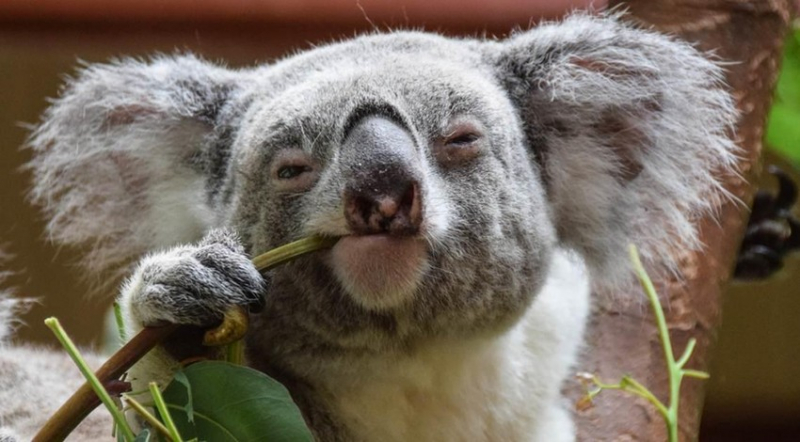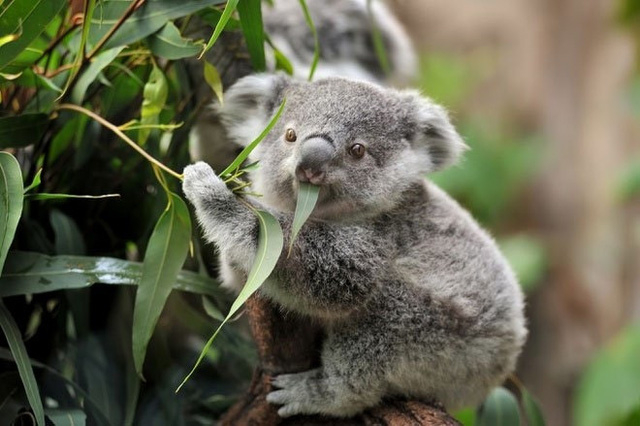
1. General description
Today, the Koala bear has become a lovely animal symbol loved by people around the world. You can easily recognize them through the image on the famous Koala cake. An adult Koala bear is from 60 cm to 85 cm in length and weighs from 4 kg to 5 kg. With their big noses, rounded ears, and silver-gray or chocolate fur, they are truly eye-catching.
Koala bears live mainly along the East and South coasts of Australia. This is one of the ‘dumbest’ mammals, with the brain accounting for only 2% of body weight. However, their uniqueness lies not only in their adorable appearance but also in the way they reproduce, eat, and live.
Adult female Koala bears can reproduce from 2-3 years old, while males need to be 3-4 years old. The gestation period is 35 days, and they rarely give birth to twins. Newborns will stay in their mother’s pouch for the first 6 months, then will begin to feed themselves, but will still stay with their mother until they reach 2-3 years of age.

2. Koala bear habitat
Koala bears, a typical resident of Australia, mainly live in the environment of eucalyptus trees. Eucalyptus trees are not only where they eat, but also where they build nests and rest. Although there are efforts to expand the living area of Koala bears, reality shows that only the presence of eucalyptus trees ensures a sustainable life for them.
Koala is a typical Australian animal, common mainly in eastern states such as Queensland, New South Wales, Victoria, and parts of South Australia. There are differences between northern and southern Koala bears, with southern ones generally being heavier and having thicker fur than northern ones.
According to the Australian Department of Environment and Energy, conservation of eucalyptus trees, along with a focus on habitat preservation, is important to protect these adorable animals.

3. Koala animal shape
The Koala, a medium-sized creature, has a distinctive shape. With a flat snout and small eyes, they appear to be a dim-looking animal. Their dark noses are wide and have thick skin. Koalas’ teeth are designed to handle tough leaves, with the incisors having exceptionally sharp edges. Their ears are round, wide apart, quite large, and have long hair at the edges.
Koala bears’ legs are elongated to easily move through tree branches. Their front feet have many sections to aid in climbing. Their legs are low and not too strong. Their curved claws help them easily cling to tree branches, and can withstand weight up to 15 kg.
What especially surprised the researcher were the Koala bear’s footprints, which were similar to human tracks. This is due to the special structure of their feet. They also have sexual organs unlike any other animal, with both females and males having two corresponding organs.
In particular, the Koala’s brain is very small compared to its body weight, accounting for only about 0.02%. Although ancestors were likely more intelligent with larger brains, with the current lifestyle of Koala bears, their brains are less active. This reduction is a special evolutionary response.
The Koala bear’s fur is short and thick, providing a pleasant feeling to the touch. However, this characteristic is also the reason why they are threatened by humans due to the attraction of their fur. The color of the coat is usually smoky gray, and the belly is usually lighter with brown that may appear.

An adult Koala bear needs to eat about 2,000 eucalyptus leaves every day to ensure nutrition and survival. With poor nutrition and difficult digestion, they move very slowly and sleep up to 22 hours a day to conserve energy. To digest a meal, it can take them 100-200 hours.
Eucalyptus leaves are not only low in nutrients, but also contain toxins. Koala bears have evolved to develop a digestive system that can fight this toxic substance.
Interestingly, the Koala bear’s body is mainly made up of digestive organs. Newborn bear cubs cannot eat leaves, so they must use their mother’s feces to survive.
Usually, Koala bears only need to drink more water when faced with harsh conditions such as drought or forest fires. However, due to climate change, the amount of water in leaves has decreased significantly.

5. Reproductive habits
Female koala bears are mature enough to reproduce at 2-3 years old, while males are 3-4 years old. A healthy koala bear can give birth to one cub every year for about 12 years. The gestation period lasts 35 days, and it is very rare for koala bears to give birth to twins. Males and females usually mate from December to March, during summer in the Southern Hemisphere.
Newborn koala bears have no fur, have not yet opened their eyes, have no ears and are only the size of a pea. After leaving the mother’s womb, they climb into their mother’s upside-down pouch, clinging to one of her nipples.
For about the first 6 months, the little koala stays in its mother’s pouch, only drinking mother’s milk. During this time, they develop ears, eyes, and fur. After a period of time, they begin to eat a thick food called “pap”, secreted by the mother bear.
The koala bear will stay with its mother for another 6 months, climbing on her back, drinking milk and eating leaves. After 12 months of staying with their mother, they go looking for food in the neighborhood on their own. However, young koala bears will continue to accompany their mothers until they are about 2-3 years old.

6. Smallest brain among mammals
People often call them Koala bears, but this animal actually belongs to the ‘marsupials’ family, which is the same family as Kangaroo, Wallaby and Possum. That means Koalas also have… pouches, where newborn koala babies will be nurtured until they are fully developed.
An interesting thing is that they possess extremely small brains, the ratio of brain size to body is only about 2% – the smallest among mammals. Notably, this brain is not only small in size, but also very light: weighing only about 19.2g and accounting for about 60% of the skull.
However, don’t let the sluggish, slow appearance deceive you. Koalas are actually capable of running as fast as rabbits, but because they want to save energy for digestion, they will avoid running when not necessary.

7. Diet secrets
Their main food is eucalyptus leaves, which are typically low in nutrients and difficult to digest. To maintain activity, Koala needs to eat 2000 eucalyptus leaves in one meal and takes up to 100-200 hours to digest. They choose to sleep to save energy.
Koalas have active gene pools in their hearts, livers and other organs that help determine the composition of leaves and juices, as well as detect bitter flavors. They have sensitive taste buds and receptors to evaluate the nutritional value of plants.
Although eucalyptus leaves contain toxic hydrocyanic acid, Koalas are not afraid. They hardly drink water, avoid attacks and keep the forest clear and sunlight reaching the low vegetation.

8. The secret of the Koala bear’s singing
Koala bears express at least 4 different sounds in their communication. Although their appearance is adorable, the sounds are a unique combination. The roaring, crying and attractive sounds of female bears during mating season can be heard up to 1 km away. They use their keen sense of hearing and smell to find partners and food.
Although their eyesight is not good, Koala bears can detect their peers and predators by hearing and smell. Fur color varies by region, with bears in the north generally being smaller and brighter in color than those in southern regions.

In the Aboriginal language, ‘Koala’ translates as ‘Don’t drink water’ as they are rarely used to water. Instead, Koalas stay hydrated by eating eucalyptus leaves – their only food. Koalas have the ability to digest these leaves thanks to a special part in their body called ‘cecum’.
However, at birth, the baby Koala’s cecum is not yet developed enough to digest eucalyptus leaves, so they must stay in their mother’s pouch to develop their digestive system. A diet poor in energy from leaves causes Koalas to sleep a lot and reduce movement.
The baby koala will be protected in the mother’s pouch for about 6-7 months, eating only mother’s milk and receiving special nutrients from the mother’s intestines to help improve the digestive system.

10. 80% of koala habitat has disappeared
In addition to natural impacts such as drought and forest fires, koala habitat is shrinking due to human intervention.
Only Australia is the home of Koala bears worldwide, especially the Eastern Australia region, where eucalyptus forests are abundant. However, cutting down trees to build farms and using land for other purposes is significantly reducing Koala habitat.
In particular, after the recent devastating forest fires in Australia, the number of Koalas decreased sharply due to burns, heat shock, and habitat loss. The image of Koalas trembling hugging tree stumps to fight the fire, or coming to the street to ask for water from people, makes people feel sad about the consequences of the forest fire disaster…

11. Koalas are ‘functionally extinct’
Koalas, the symbol of Australia, have been declared ‘functionally extinct’. This means the species is facing one of the following three conditions:
There is no longer any evidence or fossils proving their existence.
Numbers are reduced to the point where they do not make an important contribution to the ecosystem.
Too few individuals, not enough to maintain the population.
Deforestation, climate change, and drought are making food scarce. The decline in Koala numbers is not only a sign of threat for this species but also a warning of a sixth representative of global extinction.
A new report from the United Nations warns of the rapid loss of 1 million species, many of which could disappear in the next few decades, all due to human impacts.
Currently, 80% of the Koala bear’s natural habitat has been lost. According to AKF, they are facing risks from ferocious dogs and traffic accidents, causing up to 4,000 Koalas to die each year.

12. Koala conservation
The Australian Koala Foundation is the leading organization in koala conservation. They have urged the government to protect this adorable animal, and supported local authorities to implement many conservation, education and tracking strategies for Koala bears.
Although they live only in Australia, there are many non-profit organizations across the globe that are collaborating. You can contribute by donating money, buying charity products or even participating in a Koala breeding program.
The Koala bear is a precious animal symbol of Australia. Through conservation efforts, we hope to prevent the extinction that threatens this species.


